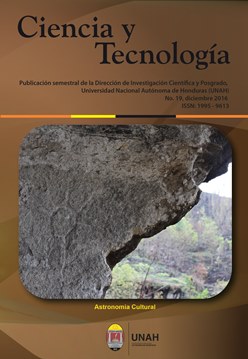Spatial and temporal variation of phytoplankton diversity and abundance of Lake Yojoa in a hydrological year 2014-2015
DOI:
https://doi.org/10.5377/rct.v0i19.4274Keywords:
Phytoplankton variation, diversity, abundance, spatial dominance, temporal dominance phytoplankton, algal bloom, Yojoa lakeAbstract
The phytoplankton of Lake Yojoa was represented by 81 species: 59% Cyanophyceae, 22% Chlorophyceae, 9% Bacillariophyceae, 4% Zignematophyceae, 3% Euglenophyceae, 2% Trebouxiophyceae and 1% Dinophyceae.
The beta phytoplankton diversity of Lake Yojoa is relatively high regardless of sampling site and time. The highest specific wealth corresponded to the station in front of the Brisas del Lago Hotel and the lowest to index point. Temporally, the greatest specific richness was in July 2014 and the lowest in January 2015, dominating: Microcystis aeruginosa, Aphanocapsa delicatissima, Aphanocapsa elachista, Oscillatoria limosa, Staurastrum leptocladum, Pseudoanabaena mucícola and Sphaerocystis schroeteri. Spatially, the highest index of dominance corresponded to Quebrada Cianuro and the lowest to Index Point. Temporally, the highest index of dominance was in July 2014 and the lowest in September and November 2014. Spatially, the greatest similarity was found between Puntilla and Cacao and Point Index, and the lowest between the mouth of the Varsovia River and the Quebrada Cianuro mouth. Temporally, the greatest similarity was during and at the end of the dry season 2015, and the lowest between July 2014 and the dry season 2015.
The average abundance was higher in May 2014 with 58,616 (Cel / ml), coinciding with the end of an algal bloom event, however, declined progressively during the study. During the first sampling, a greenish-brown superficial cream corresponding to filamentous algae (Oscillatoria limosa and Lyngbya) was observed in decomposition. The marked seasonality of phytoplankton and environmental conditions are the determinants of differences in diversity and abundance found in Lake Yojoa.
Revista Ciencia y Tecnología No.19, diciembre 2016, p.40-77
Downloads
2101
Downloads
Published
How to Cite
Issue
Section
License
© Revista Ciencia y Tecnología
Authors who publish in this journal accept the following conditions: In accordance with the legislation of copyright, Revista Ciencia y Tecnología, recognizes and respects the moral right of authors, as well as the ownership of the patrimonial right, which will be ceded to the magazine for its diffusion in open access in printed version and in digital format. By being part of multiple indexers, databases and reference systems, the articles published by Revista Ciencia y Tecnología will be visible and will be downloaded from these websites, indicating, in all cases, the authorship of the articles, the date of publication and the number of the journal to which they correspond.




